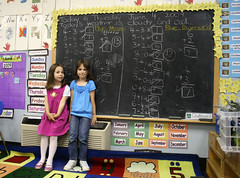 In our last post, we discussed the use of the cognitive content dictionary, a Project GLAD strategy that is designed to build academic vocabulary and word analysis skills. If you haven't read that post, you might want to read it first! You can read it by clicking here.
In our last post, we discussed the use of the cognitive content dictionary, a Project GLAD strategy that is designed to build academic vocabulary and word analysis skills. If you haven't read that post, you might want to read it first! You can read it by clicking here.On the first day we gave the students the word and asked students to make a prediction about the meaning of the word. We also used the word as a signal word, using a gesture and giving the hint to the word. Next we read poems about the word "ecologist" and pointed out the word as we read it in a text.
The next day we revisited the cognitive content dictionary and asked students to tell us the meaning of the word "ecologist". As mentioned in our first post, we did a mini-lesson on some of the word parts that the word contained. Students then put the word into an oral sentence.
One thing that we noticed throughout the day when students were using the word was that they said, "A ecologist...". We therefore thought that it was an excellent opportunity to conduct a minilesson of when the articles "a" and "an" should be used.
We then gave the students a new word and went through the same process with the new word.
A helpful reminder when practicing the cognitive content dictionary ELD strategy is that you might want to pick academic words that can be analyzed by prefixes, suffixes, root words, etc. An excellent resource for word analysis is the ESL Teacher's Book of Lists, which can be found in the ELD Strategies store. In addition, the word will need to be a word that students will be exposed to in multiple contexts such as poems, books, videos, etc.





